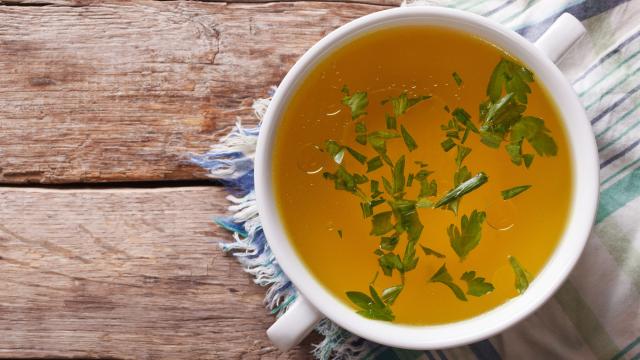Stock and broth are very similar liquids, and can be used interchangeably in many recipes without incident. There are, however, a few key differences between them, the primary being a matter of bones.
In its simplest form, broth is the liquid meat was cooked in. There are vegetarian variations on the theme, like vegetable broth and bean broth, which are simply the liquid that some vegetable or beans were cooked in, though some people might argue that those aren’t technically broth due to their lack of meat. (I am not one such pendant, but you know they are out there.)
[referenced id=”820326″ url=”https://www.lifehacker.com.au/2018/01/maximise-a-chickens-meal-potential-by-poaching-it-first/” thumb=”https://www.gizmodo.com.au/wp-content/uploads/sites/4/2018/01/25/rt2agjvpovyfan85ea6v-300×169.jpg” title=”Maximise A Chicken’s Meal Potential By Poaching It First” excerpt=”If you read about cooking online, you’ve no doubt seen several listicles that tout the many uses of a single, humble chicken. At this point, you know what a chicken can do for you, so another overly-prescriptive, chicken-based meal plan seems unnecessary. My agenda here is very simple: the next…”]
Stock, on the other hand, implies the presence of bones — bones that have been simmered for hours and hours to extract their collagen (which turns into gelatin), which is what gives stock its rich body and causes it to gel when chilled. These bones — which are very valuable — are traditionally simmered with carrot, onion, and celery, but left unseasoned. (Full disclosure: I add salt to my stock, convention be damned.) Roasting the bones beforehand can give your stock a little more flavour and a deeper colour, but you can make stock with un-roasted bones if you desire.
I’m sure you’ve seen vegetable “stock” for sale, but that stuff is “stock” in the way that almond milk is “milk” — it’s a convenient way to indicate to the home cook how the product is supposed to be utilised in their kitchen — because vegetables do not have bones. (Shellfish don’t technically have any either, but I do like to simmer their exoskeletons and call it “stock”; I am comfortable with this mainly because shrimp shells contain a bit of collagen.)
Anyway. Broth is also more of a finished product, whereas stock is meant for cooking with. You certainly can cook with broth — nothing terrible will happen to you — but it won’t have the body that you get from stock, and broth is always seasoned; you should be able to sip it and find it enjoyable, or toss some noodles in it a call it a soup. It’s also lighter in body and colour and does not typically gel when cooled, due to its shorter cooking time and/or lack of bones. (Broth can contain bones if the meat happens to be attached to them, but it can also be made with boneless meat, like chicken breasts.)
[referenced id=”777943″ url=”https://www.lifehacker.com.au/2019/11/do-bay-leaves-even-do-anything/” thumb=”https://www.gizmodo.com.au/wp-content/uploads/sites/4/2017/03/16/nvvk3vlsjspy5bpjxykj.jpg” title=”Do Bay Leaves Even Do Anything?” excerpt=”Bay leaves are the dryer sheets of the kitchen. I know that they do something, I’m just not entirely sure what it is, and I don’t really miss them when I run out. Yet I keep buying them, because this is what humans that cook do. They buy bay leaves…”]
Though “broth” technically refers to any liquid a piece of meat was cooked in, my favourite way to make chicken broth is to poach a whole chicken, using A.A. Newton’s method. I place the chicken in a pot and submerge it in water, making sure to fill the cavity so it stays submerged, and add some sliced ginger, garlic, scallions, sugar and salt. I then bring it to a boil, let it simmer for about half an hour, then cut the heat, cover it, and let it steep for at least two hours, sometimes longer.
Not only does this process yield a tender, juicy, flavourful bird, but a bangin’ broth that — once it has cooled sufficiently — is practically guzzle-able. After I’ve eaten the chicken, I toss the bones into my Instant Pot along with some vegetable scraps, a bay leaf, and some ACV to help extract the collagen, and cook it all under high pressure for an hour. (You can also simmer the carcass on the stove for a few hours to achieve the same results.)
But what of bone broth? What the heck is that?
[referenced id=”820326″ url=”https://www.lifehacker.com.au/2018/01/maximise-a-chickens-meal-potential-by-poaching-it-first/” thumb=”https://www.gizmodo.com.au/wp-content/uploads/sites/4/2018/01/25/rt2agjvpovyfan85ea6v-300×169.jpg” title=”Maximise A Chicken’s Meal Potential By Poaching It First” excerpt=”If you read about cooking online, you’ve no doubt seen several listicles that tout the many uses of a single, humble chicken. At this point, you know what a chicken can do for you, so another overly-prescriptive, chicken-based meal plan seems unnecessary. My agenda here is very simple: the next…”]
“Bone broth” is mostly a marketing term for expensive, seasoned stock meant for sipping. The main difference between “normal” traditional stock and bougie bone broth is one of flavour — like any other broth, bone broth is a finished product meant to be slurped, which means someone took the time to add salt, pepper, herbs and/or flavourful roots and powders to make it taste good enough to drink. bBut it’s still stock.
Honestly, what I make and call “stock” probably falls into this hybrid category: I like to season my stock because I think it lays a more flavourful foundation on which to build my gravies and sauces. Traditional? No. Delicious? Yes. (Once you understand the rules, you should feel emboldened to bend or break them.) Just don’t let anyone tell you that bone or meat water has magical healing properties. Both stock and broth can certainly feel restorative in the way that all good food can make you feel nice, but bones can only do so much.

Leave a Reply
You must be logged in to post a comment.